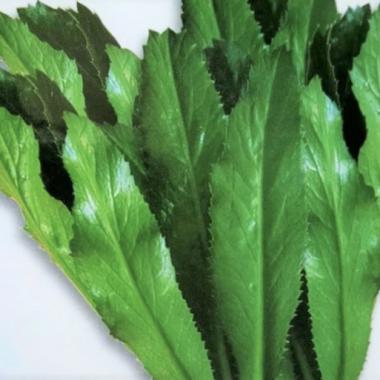


Mexican coriander
(Culantro, Bhandhania, Mexican parsley, Recao, Chandon beni)
Eryngium foetidum

Mexican coriander (Culantro) is tropical perennial herb which is only happy growing outside
in a sheltered warm position with plenty of shade.
In bright conditions it tends to bolt and produce tall flowering stalks which means the end to leaf production.
It is a native of Mexico and South America and produces long, serrated foliage up to 5 cm wide growing in a rosette,
rather like an over tall lettuce.
These leaves have a vaguely unpleasant smell when crushed raw but alter and improve with cooking.
Its flavour is stronger than the more familiar coriander and therefore it needs to be used more sparingly
and is usually added early in cooking so that the flavour can mellow.
The seed prefers warm temperatures of 25ºC for germination and may take up to 3 weeks to germinate.
Seeds should be sowed on the surface of moist compost and just covered with a minimum of compost.
Prick out as soon as they are large enough to handle.
The developing plants need a hot shady spot outside, if this is not possible a windowsill or greenhouse, out of bright sunlight, is ideal.
Culantro makes an excellent addition to a whole variety of recipes.
It is a very popular herb in South American and Caribbean cuisine, and is often found as an ingredient of sofrito.
This is a finely chopped mix consisting of onion, garlic, pepper, tomato and culanto in varying quantities
which is sautéed together to form a base for stews, rice and bean dishes.
It is also a common ingredient in some Asian dishes especially from Vietnam and Thailand, where it is known as ngu gai in Vietnamese.